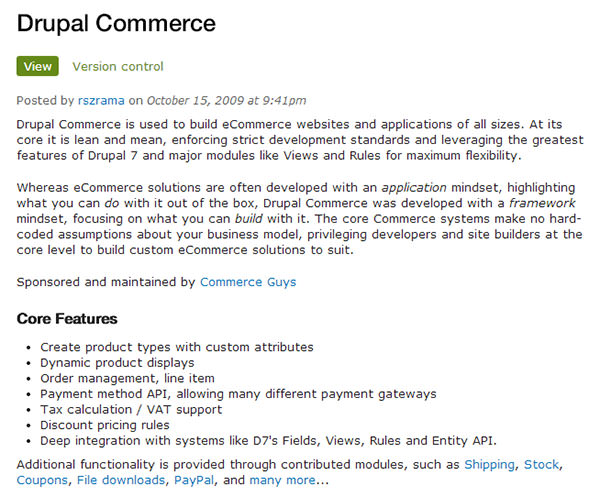

- DRUPAL COMMERCE CONFIGURATION HOW TO
- DRUPAL COMMERCE CONFIGURATION INSTALL
- DRUPAL COMMERCE CONFIGURATION PROFESSIONAL
The standard cart is a block with views, which can be configured easily and freely, as in Drupal 7. It also displays a form where attributes can be selected and based on the user's selection the information of the corresponding variation (price, image, etc. In our example case, we have almost no fields, but normally this includes image fields, text fields, categories, related products. Product pageįor each product, a page is automatically created where the values of that product are shown. The attributes would be the different sizes and colours in which the product is available. For example, different colours of the T-shirt can have different prices. The variations are the different models of that same t-shirt (the options that would generate its possible attributes) and is where you specify the price. The product for example can be a t-shirt Let's add a product with several options to choose from. In Drupal 7, it was not so obvious and could cause a big headache.Īs you can see, you can use the attributes and variations of the products you have previously created. Compared to other e-commerce systems, these are things that should already be standard. In addition, you have the option to add start and end dates, limit the number of uses, and decide whether a discount can be combined with other promotions. You can also limit promotions and special offers to a maximum order value or currency. The discount can be a fixed amount or a percentage and can be assigned to a role, a shipping address or an email address. The discount can be set for specific products or the whole order. Promotionsĭrupal Commerce provides you with a submodule that allows you to add promotions and discounts. These attributes can be assigned to types and used when adding new products.Īttributes are used to define things that are different within the same product. There are three display options available: Select List, Radio Button and Processed Attribute. Product attributesĪttributes can be added to your products. You can find more information about that functionality in the Drupal Commerce documentation. You must remember that a product can belong to one or more stores however, an order placed by the user is always assigned to one store.Īnother interesting option is the possibility of creating stores by users on your website, which allows suppliers to open their online stores on your platform, as well as create and sell their products, just like ETSY. These stores may have a country-specific offering, but they use the same database of all products that are kept in one place.

Adding more store types can be useful if you have a network of physical stores or branches in different countries. Store and store typesĪllows you to define the store types of your website, "online" is added by default. This is very useful if your website is not an E-commerce as such and you only want to have a "showcase of products" but without giving the option to buy them. Keep in mind that Drupal Commerce is very modular, this allows for example just to activate the products/variations and disable the cart or the checkout.

At first glance, you can see several options that were not included in the standard version for Drupal 7. The Commerce icon appeared in our main menu. We have activated all modules for testing purposes. After successful configuration, the list of modules will grow by 12 new entries. When using Composer, you don't have to worry about installing them manually, as they will be added automatically.
DRUPAL COMMERCE CONFIGURATION INSTALL
To install the newer Drupal Commerce, we used the following command: composer require "drupal/commerce"ĭrupal Commerce requires several additional modules (Address, Entity, Inline Entity Form, Entity Reference Revisions, Profile, State Machine). We had no problems with the installation process. Configuration and requirementsĪccording to the manual, it is recommended to install Drupal using Composer the setup requires Drupal 8.5 or later.
DRUPAL COMMERCE CONFIGURATION HOW TO
In this article, I'm going to tell how to do a very very basic installation, and show what to expect from Drupal Commerce. It leverages the power and versatility of Drupal to create customized and flexible stores, very suitable for companies that need to create their own business rules.

DRUPAL COMMERCE CONFIGURATION PROFESSIONAL
With fewer resources, we can reach more people.ĭrupal Commerce is a set of Drupal modules that allow you to create e-commerce in Drupal in a professional way. When we talk about e-commerce or electronic commerce we refer to the purchase or sale of a product through an electronic medium such as a web or app.Į-commerce is consolidating as an alternative to traditional commerce due to its diffusion power that exceeds that of traditional methods.


 0 kommentar(er)
0 kommentar(er)
